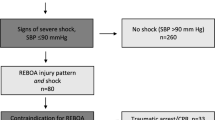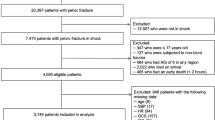Abstract
Purpose
Recently, trauma centers in the Republic of Korea introduced resuscitative endovascular balloon occlusion of the aorta (REBOA) for application in severe pelvic fracture cases. This study aimed to determine the efficacy of REBOA and its associated factors in enhancing survival.
Methods
Data from patients with severe pelvic injuries at two regional trauma centers from 2016 to 2020 were retrospectively reviewed. Patients were dichotomized into REBOA and no-REBOA groups, and patient characteristics and clinical outcomes were compared using 1:1 propensity score matching. Additional survival-based analysis was performed in the REBOA group.
Results
REBOA was performed in 42 of the 174 patients with pelvic fractures. As patients in the REBOA group had more severe injuries than did patients in the no-REBOA group, 1:1 propensity score matching was performed to adjust for severity. After matching, 24 patients were included in each group and mortality was not significantly different (REBOA 62.5% vs. no-REBOA 41.7%, P = 0.149). Kaplan–Meier analysis revealed no significant differences in mortality between the two matched groups (log-rank test, P = 0.408). Among the 42 patients treated with REBOA, 14 survived. Shorter REBOA duration (63 [40–93] vs. 166 [67–193] min, P = 0.015) and higher systolic blood pressure before REBOA (65 [58–76] vs. 54 [49–69] mmHg, P = 0.035) were associated with better survival.
Conclusions
The effectiveness of REBOA has not been definitively established; however, it was not associated with increased mortality in this study. Additional studies are required to better understand how REBOA can be effectively used for treatment.




Similar content being viewed by others
Data availability
Sorry, our IRB do not permit the opening of data.
References
Stannard A, Eliason JL, Rasmussen TE. Resuscitative endovascular balloon occlusion of the aorta (REBOA) as an adjunct for hemorrhagic shock. J Trauma. 2011;71(6):1869–72.
Pieper A, Thony F, Brun J, Rodiere M, Boussat B, Arvieux C, et al. Resuscitative endovascular balloon occlusion of the aorta for pelvic blunt trauma and life-threatening hemorrhage: a 20-year experience in a Level I trauma center. J Trauma Acute Care Surg. 2018;84(3):449–53.
Bini JK, Hardman C, Morrison J, Scalea TM, Moore LJ, Podbielski JM, et al. Survival benefit for pelvic trauma patients undergoing Resuscitative Endovascular Balloon Occlusion of the Aorta: results of the AAST Aortic Occlusion for Resuscitation in Trauma Acute Care Surgery (AORTA) Registry. Injury. 2022;53(6):2126–32.
Coccolini F, Stahel PF, Montori G, Biffl W, Horer TM, Catena F, et al. Pelvic trauma: WSES classification and guidelines. World J Emerg Surg. 2017;12:5.
Harfouche M, Inaba K, Cannon J, Seamon M, Moore E, Scalea T, et al. Patterns and outcomes of zone 3 REBOA use in the management of severe pelvic fractures: results from the AAST Aortic Occlusion for Resuscitation in Trauma and Acute Care Surgery database. J Trauma Acute Care Surg. 2021;90(4):659–65.
Mejia D, Parra MW, Ordonez CA, Padilla N, Caicedo Y, Pereira Warr S, et al. Hemodynamically unstable pelvic fracture: a damage control surgical algorithm that fits your reality. Colomb Med (Cali). 2020;51(4): e4214510.
Kang BH, Jung K, Shim H, Kim DH. Management trend for unstable pelvic bone fractures in regional trauma centers: multi-institutional study in the Republic of Korea. JAcute Care Surg. 2022;12(3):103–10.
Jung K, Matsumoto S, Smith A, Hwang K, Lee JCJ, Coimbra R. Analyses of clinical outcomes after severe pelvic fractures: an international study. Trauma Surg Acute Care Open. 2018;21(3): e000238.
Jang JY, Bae KS, Chang SW, Jung K, Kim DH, Kang BH. Current management and clinical outcomes for patients with haemorrhagic shock due to pelvic fracture in Korean regional trauma centres: a multi-institutional trial. Injury. 2022;53(2):488–95.
Park J, Jang SW, Yu B, Lee GJ, Chang SW, Kim DH, et al. An early experience of resuscitative endovascular balloon occlusion of the aorta (REBOA) in the Republic of Korea: a Retrospective Multicenter Study. J Trauma Inj. 2020;33(3):144–52.
Norii T, Crandall C, Terasaka Y. Survival of severe blunt trauma patients treated with resuscitative endovascular balloon occlusion of the aorta compared with propensity score-adjusted untreated patients. J Trauma Acute Care Surg. 2015;78(4):721–8.
Inoue J, Shiraishi A, Yoshiyuki A, Haruta K, Matsui H, Otomo Y. Resuscitative endovascular balloon occlusion of the aorta might be dangerous in patients with severe torso trauma: a propensity score analysis. J Trauma Acute Care Surg. 2016;80(4):559–66 (discussion 66-7).
Brenner M, Inaba K, Aiolfi A, DuBose J, Fabian T, Bee T, et al. Resuscitative endovascular balloon occlusion of the aorta and resuscitative thoracotomy in select patients with hemorrhagic shock: early results from the American Association for the Surgery of Trauma’s Aortic occlusion in resuscitation for trauma and acute care surgery registry. J Am Coll Surg. 2018;226(5):730–40.
Moore LJ, Brenner M, Kozar RA, Pasley J, Wade CE, Baraniuk MS, et al. Implementation of resuscitative endovascular balloon occlusion of the aorta as an alternative to resuscitative thoracotomy for noncompressible truncal hemorrhage. J Trauma Acute Care Surg. 2015;79(4):523–30 (discussion 30-2).
Hadley JB, Coleman JR, Moore EE, Lawless R, Burlew CC, Platnick B, et al. Strategies for successful implementation of resuscitative endovascular balloon occlusion of the aorta in an urban Level I trauma center. J Trauma Acute Care Surg. 2021;91(2):295–301.
Otsuka H, Sato T, Sakurai K, Aoki H, Yamagiwa T, Iizuka S, et al. Effect of resuscitative endovascular balloon occlusion of the aorta in hemodynamically unstable patients with multiple severe torso trauma: a retrospective study. World J Emerg Surg. 2018;13:49.
Johnson NL, Wade CE, Fox EE, Meyer DE, Fox CJ, Moore EE, et al. Determination of optimal deployment strategy for REBOA in patients with non-compressible hemorrhage below the diaphragm. Trauma Surg Acute Care Open. 2021;6(1): e000660.
Castellini G, Gianola S, Biffi A, Porcu G, Fabbri A, Ruggieri MP, et al. Resuscitative endovascular balloon occlusion of the aorta (REBOA) in patients with major trauma and uncontrolled haemorrhagic shock: a systematic review with meta-analysis. World J Emerg Surg. 2021;16(1):41.
Harfouche MN, Madurska MJ, Elansary N, Abdou H, Lang E, DuBose JJ, et al. Resuscitative endovascular balloon occlusion of the aorta associated with improved survival in hemorrhagic shock. PLoS One. 2022;17(3): e0265778.
Yamamoto R, Cestero RF, Suzuki M, Funabiki T, Sasaki J. Resuscitative endovascular balloon occlusion of the aorta (REBOA) is associated with improved survival in severely injured patients: a propensity score matching analysis. Am J Surg. 2019;218(6):1162–8.
Napolitano LM. Resuscitative endovascular balloon occlusion of the aorta: indications, outcomes, and training. Crit Care Clin. 2017;33(1):55–70.
Asmar S, Bible L, Chehab M, Tang A, Khurrum M, Douglas M, et al. Resuscitative endovascular balloon occlusion of the aorta vs pre-peritoneal packing in patients with pelvic fracture. J Am Coll Surg. 2021;232(1):17–26 (e2).
Theodorou CM, Anderson JE, Brenner M, Scalea TM, Inaba K, Cannon J, et al. Practice, practice, practice! effect of resuscitative endovascular balloon occlusion of the aorta volume on outcomes: data from the AAST AORTA registry. J Surg Res. 2020;253:18–25.
Chang YR, Park CY, Kim DH, Ma DS, Chang SW. A course on endovascular training for resuscitative endovascular balloon occlusion of the aorta: a pilot study for residents and specialists. Ann Surg Treat Res. 2020;99(6):362–9.
Chang SW, Kim DH, Chang YR. Educational simulation videos for performing resuscitative endovascular balloon occlusion of the aorta. J Trauma Inj. 2020;33(3):140–3.
Saito N, Matsumoto H, Yagi T, Hara Y, Hayashida K, Motomura T, et al. Evaluation of the safety and feasibility of resuscitative endovascular balloon occlusion of the aorta. J Trauma Acute Care Surg. 2015;78(5):897–903 (discussion 4).
Morrison JJ, Galgon RE, Jansen JO, Cannon JW, Rasmussen TE, Eliason JL. A systematic review of the use of resuscitative endovascular balloon occlusion of the aorta in the management of hemorrhagic shock. J Trauma Acute Care Surg. 2016;80(2):324–34.
Matsumura Y, Matsumoto J, Kondo H, Idoguchi K, Ishida T, Okada Y, et al. Early arterial access for resuscitative endovascular balloon occlusion of the aorta is related to survival outcome in trauma. J Trauma Acute Care Surg. 2018;85(3):507–11.
Manzano-Nunez R, Orlas CP, Herrera-Escobar JP, Galvagno S, DuBose J, Melendez JJ, et al. A meta-analysis of the incidence of complications associated with groin access after the use of resuscitative endovascular balloon occlusion of the aorta in trauma patients. J Trauma Acute Care Surg. 2018;85(3):626–34.
Funding
None.
Author information
Authors and Affiliations
Corresponding author
Ethics declarations
Conflict of interest
The authors have no potential conflicts of interest to disclose.
Ethics statement
The study protocol was reviewed and approved by the institutional review boards of Ajou and Dankook University Hospitals (AJOUIRB-DB-2022-513/DKUH 2202-11-028), who waived the requirement for informed consent.
Supplementary Information
Below is the link to the electronic supplementary material.
Rights and permissions
Springer Nature or its licensor (e.g. a society or other partner) holds exclusive rights to this article under a publishing agreement with the author(s) or other rightsholder(s); author self-archiving of the accepted manuscript version of this article is solely governed by the terms of such publishing agreement and applicable law.
About this article
Cite this article
Kim, D.H., Moon, J., Chang, S.W. et al. Early experience with resuscitative endovascular balloon occlusion of the aorta for unstable pelvic fractures in the Republic of Korea: a multi-institutional study. Eur J Trauma Emerg Surg 49, 2495–2503 (2023). https://doi.org/10.1007/s00068-023-02293-x
Received:
Accepted:
Published:
Issue Date:
DOI: https://doi.org/10.1007/s00068-023-02293-x




